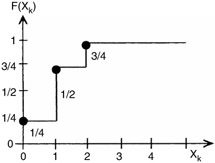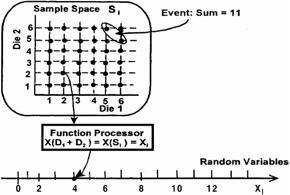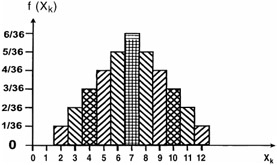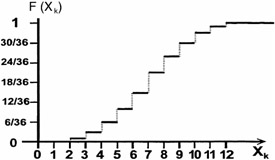DISCRETE CUMULATIVE DISTRIBUTION FUNCTION
Probability that value of the random variables X k will be less than or equal to a specified value X m .

where the capital letter F is used for cumulative distribution. If sample space is a finite number K of random variables:
x = {X 1 , X 2 , X 3 , ..., X k , ..., X m , ..., X K }
where we assume an ascending order: X k-1 < X k < X k+1 .
For example, if m = 2:
| F (X 2 ) | = | f (X 1 ) · W c + f (X 2 ) · W c |
| = | P (X 1 ) + P (X 2 ) | |
| = | P (X k ‰ X 2 ) |
Upper bound: m = K
F(X K ) = P(X k ‰ X K ) = 1
RANDOM EXPERIMENT
Two tosses of a coin.
Random Variable X k defined as number of heads. (Grouped data X k has a cell width of unity W c = 1.)
| R.V.X k Prob. Fn. f(X k ) Cumulative Prob. F(X k ) | ||
| X k < 0 | P(X < X 1 ) = 0 | |
| X 1 = 0 | f(X 1 ) = 1/4 | F(X 1 ) = P(x ‰ X 1 ) = 1/4 |
| X 2 = 1 | f(X 2 ) = 1/2 | F(X 2 ) = P(x ‰ X 2 ) |
| = P(X 1 ) + P(X 2 ) | ||
| = 1/4 + 1/2 = 3/4 | ||
| X 3 = 2 | f(X 3 ) = 1/4 | F(X 3 ) = P(x ‰ X 3 ) |
| = P(X 1 ) + P(X 2 ) + P(X 3 ) | ||
| = 1/4 + 1/2 + 1/4 = 1 | ||
Figure 16.3 shows the cumulative distribution of two tosses of a coin.

Figure 16.3: Cumulative distribution of two tosses of a coin.
RANDOM EXPERIMENT
Toss a pair of fair dice.

Individual Sample S i : Defined as sum of face values on pair of six-sided dice.
S i = D 1 + D 2
Total sample space size : N = 6 — 6 = 36 possible outcomes
Random Variable X k : Is cell equal to a specific value of S i
X k= {S i } = {D 1 + D 2 }
It is quite common in engineering to have numerical value samples.
Total number of Random Variables cells : M = 11
Range of RV: [X 1 = 2 ‰ X k ‰ 12 = X 11 ]
Other possible processes (and distributions) could include:
-
Product: S i = D 1 · D 2
-
Magnitude of difference: S i = D 1 - D 2
-
Ratio: S i = D 1 /D 2
Random Variable: (X k = {S i } = {D 1 + D 2 })
X (Die 1 + Die 2) = X(Sum) = Sum = X (Sum-1)
Example outcome:
X ([Die 1 = 1] + [Die 2 = 2]) = X(1 + 2) = 3 = X 2
Consider an event A: Set of all RVs equal to 3
{X 2 } = {[1 + 2], [2 + 1]} = {3, 3}
Sample size of event A is therefore m = 2
Probability Density: particular event {X 2 }
f(X 2 ) = P(X 2 ) = m/N
or
f(3) = P(3) = 2/36
Cumulative distribution: for random variable X 2 = 3
F(X 2 ) = f(X 1 ) + f(X 2 )
or
| F(3) | = | f(2) + f(3) |
| = | 1/36 + 2/36 = 3/36 |
S i = D 1 + D 2 = Sum of numbers appearing on face cell: X k = {S i } = {D 1 + D 2 }
The probabilities associated with each cell are shown in Table 16.1
Figure 16.4 shows the probability density function and Figure 16.5 shows the cumulative probability function.

Figure 16.4: Probability density function.

Figure 16.5: Cumulative probability function.
| R.V. X k | No. Outcomes with Value X k | f (X k ) | F (X k ) |
|---|---|---|---|
| 2 | 1 | 1/36 | 1/36 |
| 3 | 2 | 2/36 | 3/36 |
| 4 | 3 | 3/36 | 6/36 |
| 5 | 4 | 4/36 | 10/36 |
| 6 | 5 | 5/36 | 15/36 |
| 7 | 6 | 6/36 | 21/36 |
| 8 | 5 | 5/36 | 26/36 |
| 9 | 4 | 4/36 | 30/36 |
| 10 | 3 | 3/36 | 33/36 |
| 11 | 2 | 2/36 | 35/36 |
| 12 | 1 | 1/36 | 36/36 |
| Sum = 36 | 36/36 |
EAN: 2147483647
Pages: 252